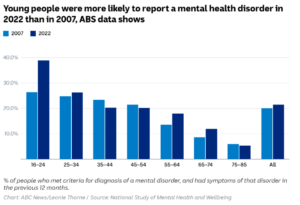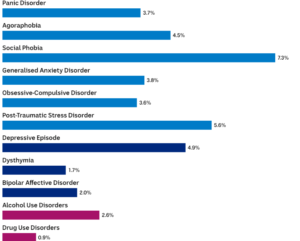Adolescent Mental Health Statistics

Most young people in Australia are happy, feel positive about the future and are satisfied with their lives overall. However, some young people suffer from poor mental health. Mental health is a state of well-being in which an individual realises their own abilities, can cope with the normal stresses of life, can work productively, and can contribute to their community.
Research into researching mental health disorders provides valuable insight into the well-being of a nation and trends regarding the ongoing state of our mental health. The National Children’s Mental Health and Wellbeing Strategy is being developed to ensure that mental illnesses are diagnosed and treated early to prevent lifelong disability (NMHC 2019).
So what does research into Adolescent Mental Health tell us about the state of young people’s being?
Findings published in the 2023 State of the Nation Report, with data collected from the annual Resilient Youth Australia Resilience Survey of around 140,000 students in Grades 3-12, across every state and territory, showed 35.9% of secondary school students report high levels of anxiety, depression, or both.
Worryingly, the 2023 report did not show improvement in the wellbeing of young people compared with data captured during the 2021 and 2022 disrupted pandemic years.
Between 40-50 per cent of students reported high levels of disengagement and falling levels of hope, across all ages and genders. Among grade 7-10 students, 5 per cent reported frequent use of vapes and alcohol consumption, rising to 11 and 15 per cent among grade 11 and 12 students, respectively.
The latest data from the Australian Bureau of Statistics (ABS) (2022) shows nearly 40 per cent of young Australians aged 16 to 24 — more than 1 million people — experienced a mental health disorder in the previous year, up from 26 per cent in 2007.

Young women were particularly affected, with nearly half (45.5 per cent) experiencing a mental health condition in the previous year, up from 30.1 per cent in 2007.
That was compared to one-third of young men (32.4 percent), up from 22.8 percent in 2007.
Anxiety disorders were the most common condition, experienced by two in five young women and one in four young men.

% persons who met criteria for diagnosis of a mental disorder and had sufficient symptoms of that disorder in the previous 12 months.
Other key findings from the report include:
- Half of all mental health conditions we experience at some point in our lives will have started by age 14.
- 75% of mental health problems occur before the age of 25.
- 13.9% of children and young people (aged 4 to 17 years) met the criteria for a diagnosis of a mental disorder in the last 12 months
- 1 in 10 young people aged between 12-17 years old will self-harm, one in 13 will seriously consider a suicide attempt, and one in 40 will attempt suicide.
- 6.9% of children and young people (aged 4 to 17 years) had suffered from an anxiety disorder in the past 12 months
- Only 31% of young women and 13% of young men with mental health problems had sought any professional help
- The prevalence of major depressive disorder is higher in young people (12 to 17 years) than in children (4 to 11 years) – 5% compared to 1.1%.
- 19.9% of all young people (11 to 17 years) had high or very high levels of psychological distress in the previous 12 months; however, for females aged 16 to 17 years and young people with major depressive disorder, this was significantly higher (36.2% and 80.7% respectively)
- In 2021-22, the rate of self-harm hospitalisation for young people aged 15-19 was 389 hospitalisations per 100,000 population, the highest of all age groups
- In 2022, deaths by suicide represented 30.9% of all deaths in young people aged 15–17 years and 32.4% of all deaths in those aged 18–24 years, up from 16.5% and 23.9% respectively of all deaths in these age groups in 2001
- Suicide contributes to premature mortality in First Nations people, especially in younger age groups. Between the years 2018-2022, almost a quarter of all deaths (22%) of First Nations people aged between 0-24 years were a result of suicide, compared to 16.8% of deaths for non-Indigenous Australians aged between 0-24
There is much speculation as to the reasons for the increase, with COVID-19 having been a major trigger for young people. Isolation is seen as a major factor in the development of anxiety and depressive problems. Also, social media plays a role.
So with these alarming statistics, it is a good reminder that there is a good chance that you may know a young person struggling with their mental health. If you are concerned, don’t be afraid to reach out to them or suggest to them that help is always available, one way or another.